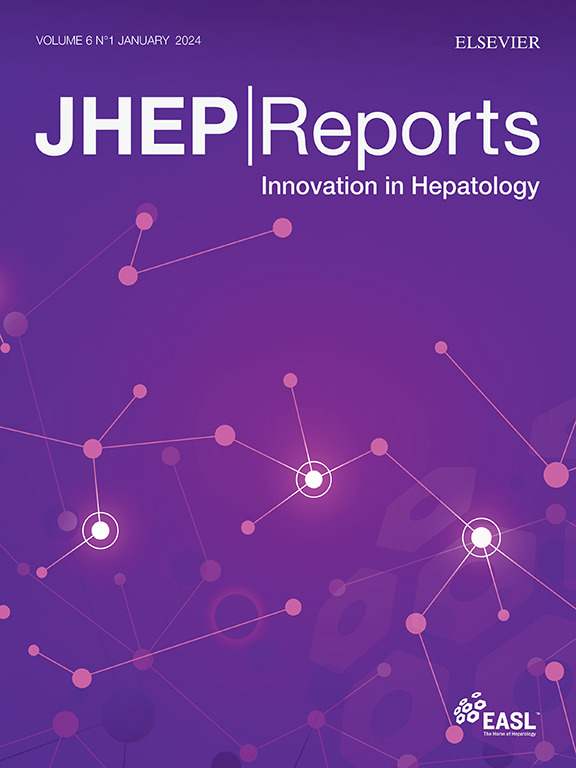深度学习增强了无钆增强缩短MRI诊断肝细胞癌的能力
IF 9.5
1区 医学
Q1 GASTROENTEROLOGY & HEPATOLOGY
引用次数: 0
摘要
背景,通过减少一些磁共振成像(MRI)序列,缩写MRI (aMRI)在检测肝细胞癌(HCC)方面显示出广泛的前景。我们的目标是开发基于深度学习(DL)的无钆对比增强(CE) aMRI方案(DL-aMRI)来检测HCC。方法回顾性纳入来自三家机构的1769例患者(913例HCC),进行培训、检测和外部验证。训练稳定的扩散DL模型生成CE-MRI,包括t1加权动脉、门静脉、移行期和肝胆期图像(分别为AP-syn、VP-syn、TP-syn和HBP-syn)。非对比MRI (NC-MRI),包括t2加权、弥散加权和预对比t1加权(Pre)序列,以及实际或dl合成的CE-MRI (AP、VP、TP和HBP或AP-syn、VP-syn、TP-syn和HBP-syn),用于创建常规完整MRI (cMRI)和DL-aMRI方案。使用非劣效性检验对DL-aMRI和cMRI之间的图像质量进行了方法间比较。采用非劣效性检验和广义估计方程模型对DL-aMRI和cMRI检测HCC的敏感性和特异性进行统计学比较。结果与cMRI相比,dl - amri的采集时间明显缩短(4.1 min vs. 28.1 min)。dl合成CE-MRI的图像质量不低于实际CE-MRI (p <0.001)。两种方法测量的肝细胞癌大小之间的方法间一致性很好(R2 = 0.9436-0.9683)。cMRI与DL-aMRI的合并敏感性和特异性分别为0.899、0.925和0.866、0.922。两种方案的敏感性和特异性均无显著差异。结论提出的DL-aMRI可以在不需要造影剂的情况下进行精确的HCC诊断,大大缩短了获取时间,并保留了NC-MRI和CE-MRI数据。DL-aMRI可作为HCC诊断的重要工具。在这项涉及1769名参与者的多中心研究中,我们开发了一种基于生成式深度学习的简化MRI (DL-aMRI)策略,该策略为检测HCC提供了一种高效、无造影剂的替代方案,其准确性与传统的完整MRI相当。将获取时间从28.1分钟显著减少到4.1分钟。对于由于长时间MRI扫描和造影剂潜在不良影响而面临大量工作量的临床医生,以及专注于开发成本效益高且易于获得的HCC检测诊断工具的研究人员来说,该策略非常有价值。提议的DL-aMRI协议对临床环境具有实际意义,在保持高图像质量的同时提高诊断效率,消除对造影剂的需求,最终使患者和医疗保健提供者受益。本文章由计算机程序翻译,如有差异,请以英文原文为准。

Deep learning empowered gadolinium-free contrast-enhanced abbreviated MRI for diagnosing hepatocellular carcinoma
Background & Aims
By reducing some magnetic resonance imaging (MRI) sequences, abbreviated MRI (aMRI) has shown extensive promise for detecting hepatocellular carcinoma (HCC). We aim to develop deep learning (DL)-based gadolinium-free contrast-enhanced (CE) aMRI protocols (DL-aMRI) for detecting HCC.
Methods
In total, 1,769 patients (913 with HCC) were retrospectively included from three institutions for training, testing, and external validation. Stable diffusion-based DL models were trained to generate CE-MRI, including T1-weighted arterial, portal venous, transitional, and hepatobiliary phase images (AP-syn, VP-syn, TP-syn, and HBP-syn, respectively). Non-contrast-MRI (NC-MRI), including T2-weighted, diffusion-weighted, and pre-contrast T1-weighted (Pre) sequences, along with either actual or DL-synthesized CE-MRI (AP, VP, TP, and HBP or AP-syn, VP-syn, TP-syn, and HBP-syn), were used to create conventional complete MRI (cMRI) and DL-aMRI protocols. An inter-method comparison of image quality between DL-aMRI and cMRI was conducted using a non-inferiority test. The sensitivity and specificity of DL-aMRI and cMRI for detecting HCC were statistically compared using the non-inferiority test and generalized estimating equations models.
Results
DL-aMRI showed a remarkable reduction in acquisition time compared with cMRI (4.1 vs. 28.1 min). The image quality of DL-synthesized CE-MRI was not inferior to that of actual CE-MRI (p <0.001). There was an excellent inter-method agreement between the HCC sizes measured by the two protocols (R2 = 0.9436–0.9683). The pooled sensitivity and specificity of cMRI and DL-aMRI were 0.899 and 0.925 and 0.866 and 0.922, respectively. No significant differences were found between the sensitivity and specificity of the two protocols.
Conclusions
The proposed DL-aMRI could facilitate precise HCC diagnosis with no need for contrast agents, a substantial reduction in acquisition time, and preservation of both NC-MRI and CE-MRI data. DL-aMRI may serve as a valuable tool for HCC diagnosing.
Impact and implications
In this multi-center study involving 1,769 participants, we developed a generative deep learning-based abbreviated MRI (DL-aMRI) strategy that provides an efficient, contrast-agent-free alternative for detecting HCC with accuracy comparable to that of conventional complete MRI, significantly reducing acquisition time from 28.1 min to just 4.1 min. This strategy is valuable for clinicians who face significant workloads resulting from long MRI scanning times and the potential adverse effects of contrast agents, as well as for researchers focused on developing cost-effective and accessible diagnostic tools for HCC detection. The proposed DL-aMRI protocol has practical implications for clinical settings, enhancing diagnostic efficiency while maintaining high image quality, eliminating the need for contrast agents and ultimately benefiting patients and healthcare providers.
求助全文
通过发布文献求助,成功后即可免费获取论文全文。
去求助
来源期刊

JHEP Reports
GASTROENTEROLOGY & HEPATOLOGY-
CiteScore
12.40
自引率
2.40%
发文量
161
审稿时长
36 days
期刊介绍:
JHEP Reports is an open access journal that is affiliated with the European Association for the Study of the Liver (EASL). It serves as a companion journal to the highly respected Journal of Hepatology.
The primary objective of JHEP Reports is to publish original papers and reviews that contribute to the advancement of knowledge in the field of liver diseases. The journal covers a wide range of topics, including basic, translational, and clinical research. It also focuses on global issues in hepatology, with particular emphasis on areas such as clinical trials, novel diagnostics, precision medicine and therapeutics, cancer research, cellular and molecular studies, artificial intelligence, microbiome research, epidemiology, and cutting-edge technologies.
In summary, JHEP Reports is dedicated to promoting scientific discoveries and innovations in liver diseases through the publication of high-quality research papers and reviews covering various aspects of hepatology.
 求助内容:
求助内容: 应助结果提醒方式:
应助结果提醒方式:


